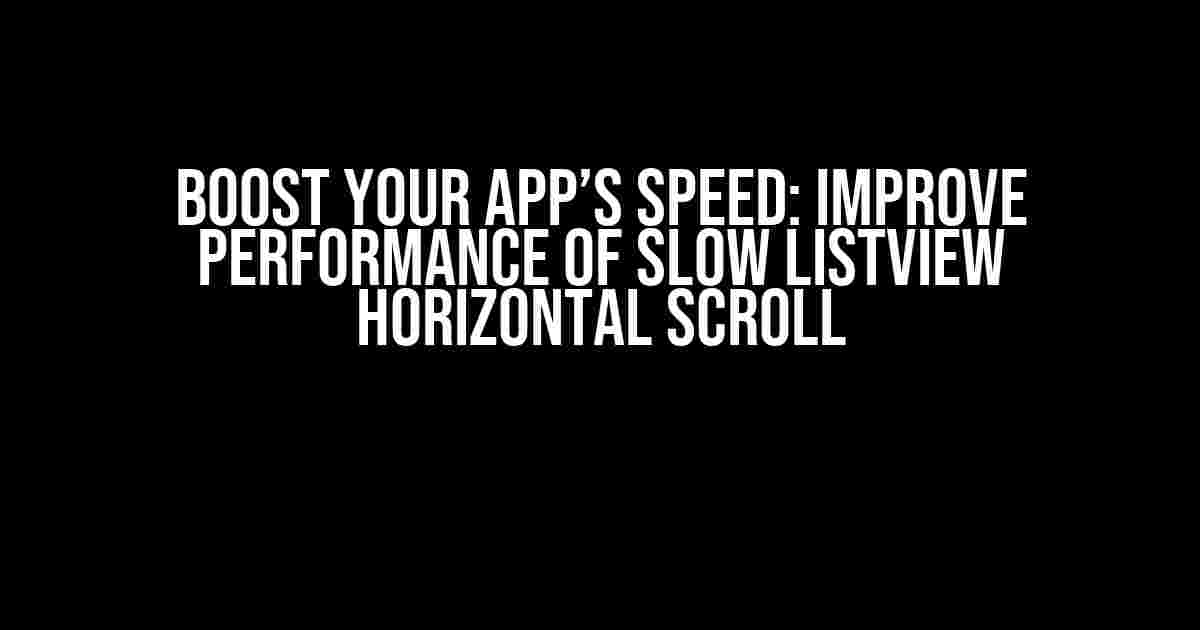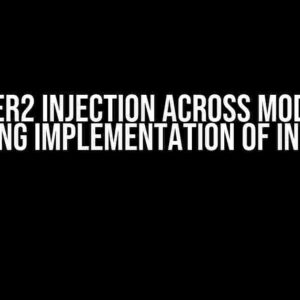Are you tired of dealing with a slow and sluggish ListView horizontal scroll in your app? Do you want to provide a seamless user experience for your users? Look no further! In this article, we’ll dive deep into the world of optimization techniques to help you improve the performance of your slow ListView horizontal scroll.
Understanding the Problem
A slow ListView horizontal scroll can be frustrating for users and detrimental to your app’s overall performance. But what causes this issue in the first place? Here are some common culprits:
- Complex layouts and nested views
- Heavy image loading and caching
- Inefficient adapter implementations
- Poor memory management
Identifying the root cause of the problem is crucial in developing an effective solution. Let’s explore each of these factors in more detail.
Complex Layouts and Nested Views
A complex layout with multiple nested views can lead to slow rendering and scrolling. This is because the system has to perform additional calculations to measure and layout each view, resulting in increased processing time.
<LinearLayout>
<RelativeLayout>
<ImageView>...</ImageView>
<TextView>...</TextView>
</RelativeLayout>
<RelativeLayout>
<ImageView>...</ImageView>
<TextView>...</TextView>
</RelativeLayout>
</LinearLayout>In the above example, the LinearLayout contains multiple RelativeLayouts, each with an ImageView and a TextView. This nested structure can lead to slow rendering and scrolling.
Heavy Image Loading and Caching
Loading and caching large images can consume significant system resources, leading to slow scroll performance. This is especially true when dealing with large datasets.
ImageView imageView = (ImageView) itemView.findViewById(R.id.image_view);
ImageLoader.getInstance().displayImage(imageUrl, imageView);In the above example, the ImageLoader is used to load and display images in the ListView. However, if the images are large or numerous, this can lead to slow scrolling.
Inefficient Adapter Implementations
A poorly implemented adapter can lead to slow scrolling and performance issues. This is often due to inefficient use of resources or unnecessary calculations.
public View getView(int position, View convertView, ViewGroup parent) {
ViewHolder viewHolder;
if (convertView == null) {
viewHolder = new ViewHolder();
convertView = LayoutInflater.from(getContext()).inflate(R.layout.list_item, parent, false);
viewHolder.textView = (TextView) convertView.findViewById(R.id.text_view);
convertView.setTag(viewHolder);
} else {
viewHolder = (ViewHolder) convertView.getTag();
}
viewHolder.textView.setText(data.get(position));
return convertView;
}In the above example, the adapter implementation is inefficient due to unnecessary calculations and object creations.
Poor Memory Management
Poor memory management can lead to memory leaks and slow performance. This is often due to retaining unnecessary references to objects or failing to release resources.
private List<Data> dataList = new ArrayList<>();
public void onDestroy() {
super.onDestroy();
dataList.clear();
// Failing to release resources
}In the above example, the dataList is cleared but the resources are not released, leading to memory leaks and slow performance.
Optimization Techniques
Now that we’ve identified the common causes of slow ListView horizontal scroll, let’s explore some optimization techniques to improve performance.
Simplify Your Layout
Simplifying your layout can significantly improve performance. This can be achieved by:
- Reducing the number of nested views
- Using RelativeLayout instead of LinearLayout
- Removing unnecessary views
<RelativeLayout>
<ImageView
android:id="@+id/image_view"
.../>
<TextView
android:id="@+id/text_view"
.../>
</RelativeLayout>In the above example, the complex layout has been simplified by removing unnecessary views and using a RelativeLayout.
Optimize Image Loading and Caching
Optimizing image loading and caching can improve performance by:
- Using a memory-efficient image loader like Glide or Picasso
- Resizing images to reduce memory consumption
- Caching images to reduce network requests
Glide.with(context)
.load(imageUrl)
.override(100, 100) // Resize images
.into(imageView);In the above example, Glide is used to load and resize images, reducing memory consumption and improving performance.
Implement an Efficient Adapter
Implementing an efficient adapter can improve performance by:
- Using a ViewHolder pattern to reduce object creations
- Avoiding unnecessary calculations and resources
- Using a RecyclerView instead of ListView
public class EfficientAdapter extends RecyclerView.Adapter<EfficientAdapter.ViewHolder> {
private List<Data> dataList;
public EfficientAdapter(List<Data> dataList) {
this.dataList = dataList;
}
@Override
public ViewHolder onCreateViewHolder(ViewGroup parent, int viewType) {
View itemView = LayoutInflater.from(parent.getContext()).inflate(R.layout.list_item, parent, false);
return new ViewHolder(itemView);
}
@Override
public void onBindViewHolder(ViewHolder holder, int position) {
holder.textView.setText(dataList.get(position));
}
@Override
public int getItemCount() {
return dataList.size();
}
public class ViewHolder extends RecyclerView.ViewHolder {
public TextView textView;
public ViewHolder(View itemView) {
super(itemView);
textView = (TextView) itemView.findViewById(R.id.text_view);
}
}
}In the above example, the adapter implementation uses a ViewHolder pattern and avoids unnecessary calculations, reducing object creations and improving performance.
Implement Efficient Memory Management
Implementing efficient memory management can improve performance by:
- Releasing resources in onDestroy()
- Avoiding memory leaks by using weak references
- Using a memory profiler to identify memory issues
private List<Data> dataList = new ArrayList<>();
public void onDestroy() {
super.onDestroy();
dataList.clear();
dataList = null; // Release resources
}In the above example, the resources are released in onDestroy() to prevent memory leaks and improve performance.
Conclusion
In this article, we’ve explored the common causes of slow ListView horizontal scroll and provided optimization techniques to improve performance. By simplifying your layout, optimizing image loading and caching, implementing an efficient adapter, and implementing efficient memory management, you can significantly improve the performance of your app.
Remember, optimizing performance is an ongoing process that requires continuous monitoring and testing. By using the techniques outlined in this article, you can provide a seamless user experience for your users and improve the overall performance of your app.
| Technique | Description |
|---|---|
| Simplify Your Layout | Reduce the number of nested views and use RelativeLayout instead of LinearLayout |
| Optimize Image Loading and Caching | Use a memory-efficient image loader, resize images, and cache images to reduce network requests |
| Implement an Efficient Adapter | Use a ViewHolder pattern, avoid unnecessary calculations and resources, and use a RecyclerView instead of ListView |
| Implement Efficient Memory Management | Release resources in onDestroy(), avoid memory leaks by using weak references, and use a memory profiler to identify memory issues |
By following these optimization techniques, you can improve the performance of your slow ListView horizontal scroll and provide a better user experience for your users.
Final Thoughts
In conclusion, improving the performance of your slow ListView horizontal scroll requires a comprehensive approach that addresses layout complexity, image loading and caching, adapter implementation, and memory management. By applying the techniques outlined in this article, you can significantly improve the performance of your app and provide a seamless user experience for your users.
Remember, performance optimization is an ongoing process that requires continuous monitoring and testing. By staying up-to-date with the latest optimization techniques and best practices, you can ensure that your app remains fast, efficient, and user-friendly.
Happy optimizing!
Frequently Asked Question
Get ready to boost the performance of your slow ListView horizontal scroll with these expert-approved tips!
What’s the main reason behind my slow ListView horizontal scroll?
The primary culprit behind a slow ListView horizontal scroll is often the inefficient use of resources, such as excessive layout inflation, complex view hierarchies, and poorly optimized adapter implementations. Identifying and addressing these performance bottlenecks is crucial to improving the scrolling experience.
How can I optimize my ListView adapter for better performance?
To optimize your ListView adapter, implement the ViewHolder pattern to reduce view inflation, use a caching mechanism to store frequently accessed data, and consider using a RecyclerView instead of a ListView for more efficient row reuse. Additionally, minimize the number of database queries and perform complex computations in a background thread.
What’s the impact of layout inflation on my ListView’s performance?
Layout inflation can significantly slow down your ListView’s performance, especially when dealing with complex layouts or large datasets. To mitigate this, use a ViewStub or lazy loading to delay the inflation of non-visible views, and consider optimizing your layout hierarchy to reduce the number of views being inflated.
Can using a RecyclerView improve my ListView’s horizontal scrolling performance?
Absolutely! RecyclerView is designed to handle large datasets and scrolling more efficiently than ListView. By using a RecyclerView with a horizontal LinearLayoutManager, you can take advantage of features like row reuse and batching, which can significantly improve your app’s performance and responsiveness.
What tools can I use to profile and debug my ListView’s performance issues?
Android Studio provides a range of tools to help you profile and debug performance issues, including the Android Profiler, Systrace, and the Layout Inspector. These tools allow you to analyze CPU usage, memory allocation, and layout hierarchy, making it easier to identify and fix performance bottlenecks in your ListView.


